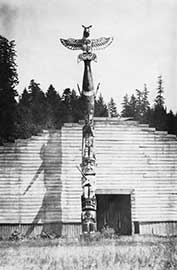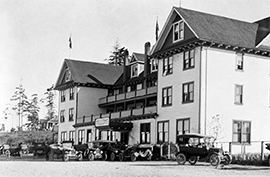The First Nations on the coast have known of the excellent salmon runs on the Campbell River for centuries. Their village site at the mouth of the river was named Tlamatook, meaning “a place where there are houses.” Archaeological digs at this site have revealed extensive use as a permanent village and fishing site for millennia.
Europeans first reached this region in 1792 with both the Spanish and English sending ships to chart and explore the area. Captains Vancouver and Galiano worked together to chart this island and rapid strewn  section of the coast. When Captain Vancouver reached Discovery Passage, he stopped to visit the First Nations village on the cliffs at what is now called Cape Mudge. It is believed that this village was then populated by Salish speaking peoples, but it is possible that the Laichwiltach (a confederacy[1] of Liqwala speaking[2] nations) had already begun their southward expansion into this area. Certainly by the mid 1800s the Laichwiltach controlled the strategic trading position and rich salmon grounds of Discovery Passage from their villages at Tlamatook (Campbell River) and Tsa-kwa-luten (Cape Mudge).
section of the coast. When Captain Vancouver reached Discovery Passage, he stopped to visit the First Nations village on the cliffs at what is now called Cape Mudge. It is believed that this village was then populated by Salish speaking peoples, but it is possible that the Laichwiltach (a confederacy[1] of Liqwala speaking[2] nations) had already begun their southward expansion into this area. Certainly by the mid 1800s the Laichwiltach controlled the strategic trading position and rich salmon grounds of Discovery Passage from their villages at Tlamatook (Campbell River) and Tsa-kwa-luten (Cape Mudge).
The next Europeans to survey this area came in the period 1859-1861 when Captain Richards of HMS Plumper was sent by the Royal Canadian Navy to chart the area. The name “Campbell” was not applied to the river until that time. The river was named for the surgeon onboard, Dr. Samuel Campbell.
Prior to Captain Richards’ survey, Europeans did not have much of a presence in this area; it was only after European interests shifted to logging in the 1860s that they came to this area in greater numbers. The first loggers did not intend to stay; they were logging off the easily accessible timber along the shoreline, and then moving on. Many of the logging camps were built on floats to expedite this process. Only once the easily accessible timber was logged did the camps start harvesting the timber that was further inland, using oxen and later steam technology to move the logs to the water for shipping to the mills.
A settlement was planned and prospected to be located at Duncan Bay (a large natural harbour just north of the river) by Mike King in the 1880s. This settlement was going to be called Duluth, but it was never built. Europeans began to settle at Campbell River starting in the late 1880s with Fred Nunns being one of the first. You will find many places in Campbell River named for Fred Nunns and the other early settlers.
 This area has long been famous for its fishing and people have come from far and wide to enjoy the fishing (and hunting) here, so it is not surprising to learn that the first business established in Campbell River was a hotel, in 1904, known as the Willows Hotel, built by Charles and Frederick Thulin. In 1910, a large party headed by BC’s Commissioner of Lands stayed here before setting out on an exploratory survey of central Vancouver Island. Their expedition resulted in the establishment of BC’s first provincial park, Strathcona Park.
This area has long been famous for its fishing and people have come from far and wide to enjoy the fishing (and hunting) here, so it is not surprising to learn that the first business established in Campbell River was a hotel, in 1904, known as the Willows Hotel, built by Charles and Frederick Thulin. In 1910, a large party headed by BC’s Commissioner of Lands stayed here before setting out on an exploratory survey of central Vancouver Island. Their expedition resulted in the establishment of BC’s first provincial park, Strathcona Park.
All incoming and outgoing transportation to Campbell River was by water, and for a town without a natural harbour, this caused some difficulties. Quathiaski Cove, on Quadra Island, which had be settled much earlier than Campbell River, served as the economic and social hub of the region in the early 20th century. Only after the road came through from Courtenay in 1920 did Campbell River come into its own as a regional centre.
While Campbell River grew as a service centre surrounded by large logging camps, it also played host to increasing numbers of visitors bent on catching the impressive Tyee salmon, distinguished from other salmon by weighing over 30 pounds. In 1924, to regulate and protect the sport, the Tyee Club of British Columbia established a set of rules which are still adhered to by the Club to this day. The Tyee Club is Campbell River’s oldest organization.
In the 1940s, a huge hydro-electric project began to develop the power potential of the Campbell River system. It included construction of three dams and took 13 years to complete, bringing prosperity and a building boom to the community. It also brought with it a great deal of environmental activism as residents fought to protect the ecosystems of the lakes, and river, especially the salmon runs that made the Campbell River so famous. One particularly outspoken conservationist was prominent community member Roderick Haig-Brown. A world renowned writer known for his eloquence on fly fishing, Haig-Brown was ahead of his time in his concern for the environment and became an active spokesperson for the principles of conservation, particularly regarding rivers and salmon. Today, the family home and property on the river is a provincial Heritage Site known as the Haig-Brown Heritage House, and is managed by the Museum at Campbell River.
In 1952, the opening of the Elk Falls Pulp and Paper Mill further escalated Campbell River’s development and growth. The Elk Falls Mill was the community’s largest employer until it closed in 2010. The mill was a prominent supporter of the community over the years. The company participated in parades and festivals and even had its own local baseball team at one time.
An event of national interest took place in April 1958. Seymour Narrows, near Campbell River, was the site of the largest non-nuclear explosion in history when 1,400 tons of dynamite blasted away a marine hazard known as Ripple Rock. Over the years, Ripple Rock was responsible for numerous shipwrecks and lost lives. After two and a half years of preparation, the hazard was removed in a spectacular eruption of rock and water 300 metres (1,000 ft) high. Viewers across the country were able to witness the explosion on one Canada’s first live television broadcasts.
The next major event to stir up the community of Campbell River was the plan to build the Tyee Plaza. This development required re-claiming the waterfront next to the downtown shopping area (today’s Shoppers Row) by filling in the bay. The development was a heavily contested one, and took years to be realised. Although initially proposed in 1955, the construction work did not begin on dredging and filling the bay until 1958. In the interim years, the development was hotly debated in the community: there were multiple community plebiscites, village commission rulings, and law suits filed for slander. In the end the developer went directly to the federal and provincial governments to get the go-ahead for the project, by-passing the village completely. One of the most difficult issues for the community was the fact that car ferry service to Quadra Island was tied to the development plan. Car ferry service was desperately needed due to the loss of the Union Steamship Service to the area. The ferry was running by 1960 and the Tyee Plaza shopping centre was open for business in 1962.
Campbell Riverites, as the local residents are called, have, since the town’s beginnings at the Willows Hotel, enjoyed their entertainment. It came as no surprise when the town rallied together in the 1980s and ‘90s to support the development of several new local arts institutions. In 1987, the old Van Isle movie theatre, after two years of dedicated work from a volunteer committee, re-opened as the Tidemark Theatre and became the first performing arts theatre in Campbell River. While the Museum at Campbell River had been established in 1958, it was in desperate need of a newer and larger space. After more than 10 years of fundraising, grant applications, and hard work, the new purpose built facility opened in 1994 to great fan fare. In the same year, Campbell River opened its first public Art Gallery in the Centennial Building which had just been vacated by the Museum.
The 1980s and 1990s brought another change to Campbell River with the arrival of the Homalco or Xwemalhkwu First Nation. The traditional territories of the Homalco, an Ey7a7uuthem speaking[3] First Nation, are to the east of Campbell River primarily on the mainland and encompass all of Bute Inlet. The community at Aup (Church House) was struggling in the 1970s due to the general lack of services and a faltering fishing economy, which caused the dispersal of the Homalco peoples to larger centres. In the 1980s community leaders negotiated with the government to purchase lands for a new community centre in the Campbell River area. Construction began in 1992.
Development was changing the shoreline of Campbell River yet again, with the construction of the Discovery Harbour Centre on Weiwaikum First Nation reserve land. The project was the first of its kind in Canada where the First Nation partnered with the development firm, Northwest Group, rather than just leasing out the land. More of the shoreline was re-claimed with fill, and the marina, offices, shopping centre, and restaurants were opened with celebrations and fireworks in 1998. Visitors to the shopping centre will notice the prominence given to First Nations designs on all the buildings and in the many figures and structures scattered throughout.
Campbell River was incorporated as a city in 2005.
Information submitted by the Campbell River Museum.
[1] The Laichwiltach originally comprised several nations, but through population loss several of those nations have ceased to be distinct groups. In Campbell River today there are two nations of the Laichwiltach confederacy, the Weiwaikum whose reserve is in downtown Campbell River and on the spit, and the Weiwaikai who have a reserve and settlement at Quinsam and their primary community centre at Cape Mudge on Quadra Island.
[2] Liqwala is closely related to Kwakwala which is the language spoken by the nations to the North
[3] Ey7a7uuthem is a language spoken by a number of Coast Salish First Nations including the Sliammon and Klahoose, a variant of this language was also spoken by the Comox.